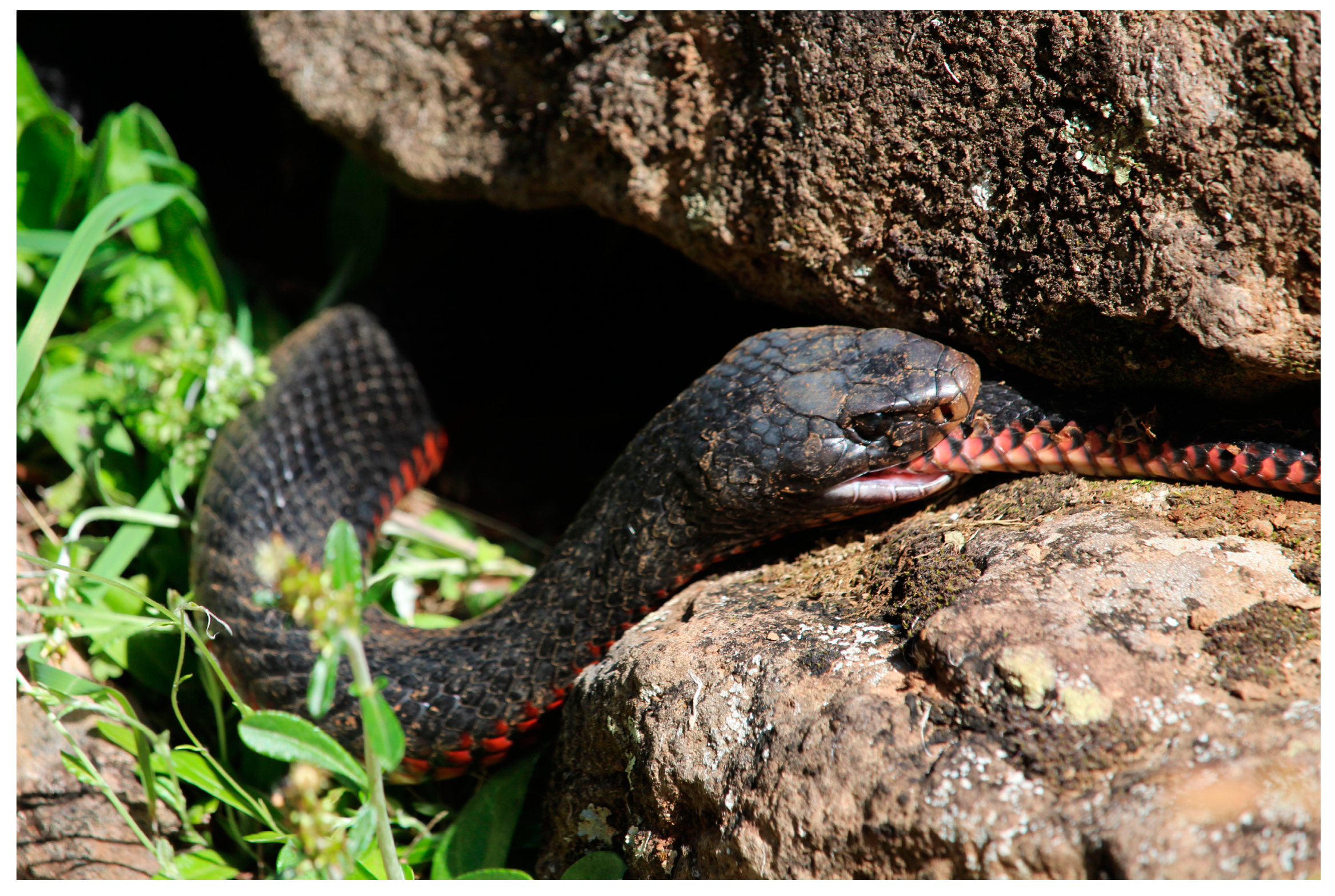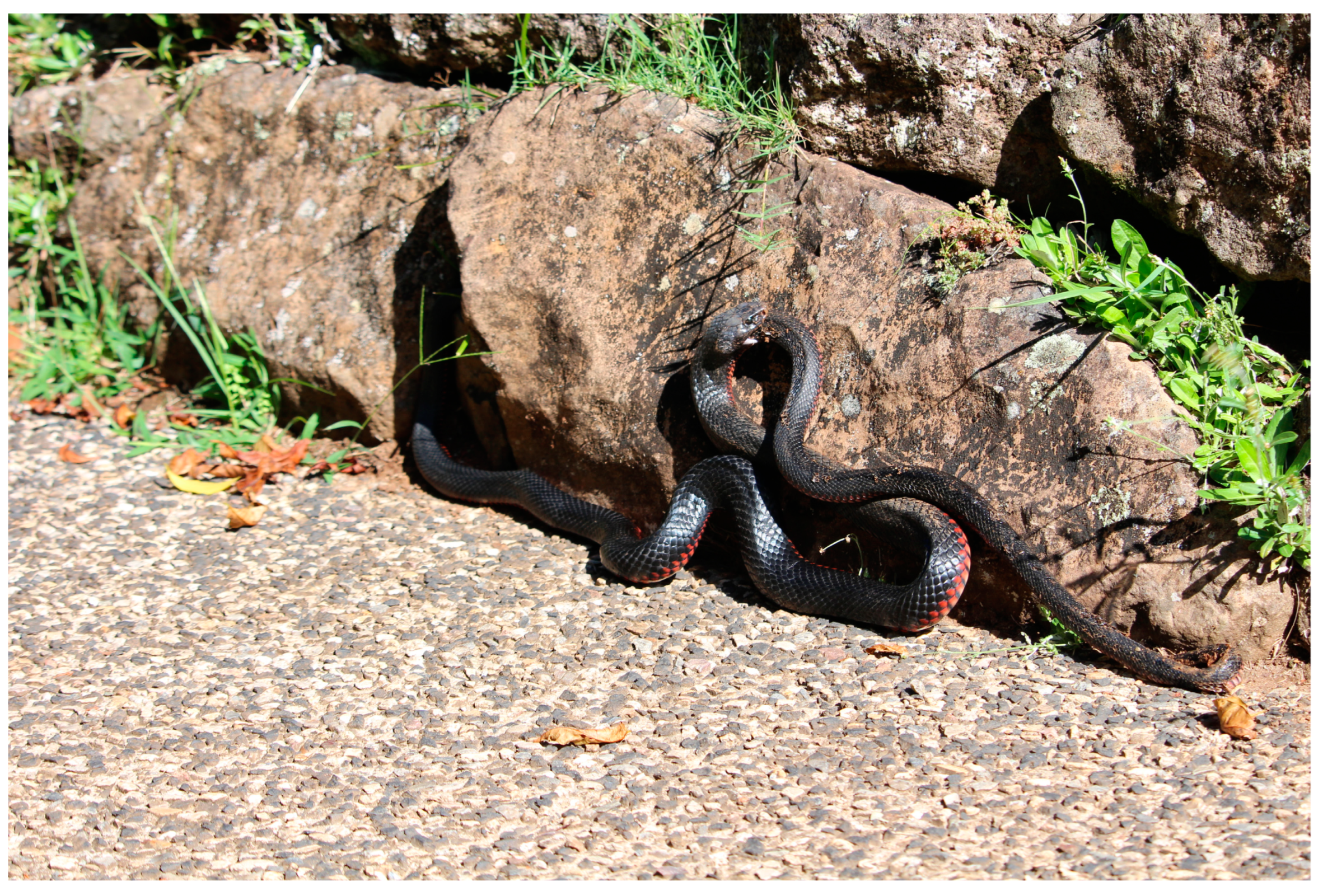Quid Pro Quo: A Documented Case of Cannibalism in the Red-Bellied Black Snake Pseudechis porphyriacus in Lamington (Queensland, Australia)
Abstract
Funding
Institutional Review Board Statement
Informed Consent Statement
Data Availability Statement
Acknowledgments
Conflicts of Interest
References
- Eipper, S.; Eipper, T. Naturalist’s Guide to the Snakes of Australia; John Beaufoy Publishing Ltd.: Oxford, UK, 2020. [Google Scholar]
- Uetz, P.; Koo, M.; Aguilar, R.; Brings, E.; Catenazzi, A.; Chang, A.; Chaitanya, R.; Freed, P.; Gross, J.; Hammermann, M.; et al. A Quarter Century of Reptile and Amphibian Databases. Herpetol. Rev. 2021, 52, 246–255. [Google Scholar]
- Goldenberg, J.; Cipriani, V.; Jackson, T.N.W.; Arbuckle, K.; Debono, J.; Dashevsky, D.; Panagides, N.; Ikonomopoulou, M.P.; Koludarov, I.; Li, B.; et al. Proteomic and Functional Variation within Black Snake Venoms (Elapidae: Pseudechis). Comp. Biochem. Physiol. Part C Toxicol. Pharmacol. 2018, 205, 53–61. [Google Scholar] [CrossRef] [PubMed]
- Lim, A.Y.L.; Singh, P.N.; Isbister, G.K. Severe Rhabdomyolysis from Red-Bellied Black Snake (Pseudechis porphyriacus) Envenoming despite Antivenom. Toxicon 2016, 117, 46–48. [Google Scholar] [CrossRef] [PubMed]
- Sanhajariya, S.; Duffull, S.B.; Isbister, G.K. Population Pharmacokinetics of Pseudechis porphyriacus (Red-Bellied Black Snake) Venom in Snakebite Patients. Clin. Toxicol. 2021, 59, 956–962. [Google Scholar] [CrossRef] [PubMed]
- Padula, A.M.; Leister, E.M. Severe Neurotoxicity Requiring Mechanical Ventilation in a Dog Envenomed by a Red-Bellied Black Snake (Pseudechis porphyriacus) and Successful Treatment with an Experimental Bivalent Whole Equine IgG Antivenom. Toxicon 2017, 138, 159–164. [Google Scholar] [CrossRef] [PubMed]
- Wun, M.K.; Padula, A.M.; Greer, R.M.; Leister, E.M. A Review of 91 Canine and Feline Red-Bellied Black Snake (Pseudechis porphyriacus) Envenomation Cases and Lessons for Improved Management. Aust. Vet. J. 2022, 100, 318–328. [Google Scholar] [CrossRef] [PubMed]
- Sanhajariya, S.; Duffull, S.B.; Isbister, G.K. Investigating Myotoxicity Following Australian Red-Bellied Black Snake (Pseudechis porphyriacus) Envenomation. PLoS ONE 2021, 16, e0256653. [Google Scholar] [CrossRef] [PubMed]
- Weinstein, S.A.; Mirtschin, P.J.; Tristram, H.; Lawton, L.; White, J. Local Morbidity from Red-Bellied Black Snake (Pseudechis porphyriacus, Elapidae) Envenoming: Two Cases and a Brief Review of Management. Toxicon 2018, 142, 34–41. [Google Scholar] [CrossRef] [PubMed]
- Shine, R. The Evolution of Viviparity: Ecological Correlates of Reproductive Mode within a Genus of Australian Snakes (Pseudechis: Elapidae). Copeia 1987, 3, 551–563. [Google Scholar] [CrossRef]
- Mo, M.; Hayler, P.; Hayler, A. Observations of Australian Red-Bellied Blacksnakes (Pseudechis porphyriacus) Preying on Freshwater Eels. Reptiles Amphib. 2020, 27, 91–93. [Google Scholar] [CrossRef]




Disclaimer/Publisher’s Note: The statements, opinions and data contained in all publications are solely those of the individual author(s) and contributor(s) and not of MDPI and/or the editor(s). MDPI and/or the editor(s) disclaim responsibility for any injury to people or property resulting from any ideas, methods, instructions or products referred to in the content. |
© 2023 by the author. Licensee MDPI, Basel, Switzerland. This article is an open access article distributed under the terms and conditions of the Creative Commons Attribution (CC BY) license (https://creativecommons.org/licenses/by/4.0/).
Share and Cite
Lüddecke, T. Quid Pro Quo: A Documented Case of Cannibalism in the Red-Bellied Black Snake Pseudechis porphyriacus in Lamington (Queensland, Australia). Diversity 2023, 15, 610. https://doi.org/10.3390/d15050610
Lüddecke T. Quid Pro Quo: A Documented Case of Cannibalism in the Red-Bellied Black Snake Pseudechis porphyriacus in Lamington (Queensland, Australia). Diversity. 2023; 15(5):610. https://doi.org/10.3390/d15050610
Chicago/Turabian StyleLüddecke, Tim. 2023. "Quid Pro Quo: A Documented Case of Cannibalism in the Red-Bellied Black Snake Pseudechis porphyriacus in Lamington (Queensland, Australia)" Diversity 15, no. 5: 610. https://doi.org/10.3390/d15050610
APA StyleLüddecke, T. (2023). Quid Pro Quo: A Documented Case of Cannibalism in the Red-Bellied Black Snake Pseudechis porphyriacus in Lamington (Queensland, Australia). Diversity, 15(5), 610. https://doi.org/10.3390/d15050610







